ABOVE: 1982 Triumph Bonneville T140E Electro, with electric start. This one has the optional 7-spoke cast aluminum “mag wheels”.
MODEL DESIGNATIONS
As the skies continued to darken at Triumph, the resourceful fellows at Meriden Co-op needed to come up with ever new ways to dress up the same old antiquated design. They had hit on the concept of Limited Edition Specials with the 1977 Triumph T140VJ Bonneville Silver Jubilee, which was a minor hit for the cash-strapped company. They did it again in 1979 & 1980 with the Triumph T140D Bonneville Special. In 1981, there was the Triumph Bonneville Executive (a touring model available with electric start (T140ES) or kickstart-only (T140E), and the T140AV (Anti-Vibration) intended & being evaluated for Police work. Now, for the 1982 Triumph Bonneville, the theme for their new bike fell into their laps. Prince Charles, Duke of Wales, and Lady Diane Spencer were wed & Triumph built yet another limited-edition motorcycle to commemorate it, the 1982 Triumph Bonneville T140LE Royal Wedding. The T140E (“E” for Environmental, kickstart-only), the T140ES (electric starter) & the Bonneville Executive were still in the model line-up for 1982.
BELOW: Note the unsightly bulge in the timing cover of this 1982 Triumph Bonneville ‘Electro’ to accommodate the starter drive.
1982 Triumph Bonneville T140LE “ROYAL WEDDING”
CELEBRATING A ROYAL WEDDING
By 1982, Triumph was on the ropes. They were unable to re-engineer their bikes they way they needed to, or even produce enough units to make a profit, due to their severe financial constraints. It was thought that lower-volume, higher-profit “special models” might save the day. Several were proposed and a few were tried. Most fizzled in the marketplace. One such effort was the T140LE Royal Wedding, built to commemorate the British royal wedding of Prince Charles to Lady Diana Spencer. Built in very low numbers, believed to be less than 1,000, the Royal Wedding was styled differently, depending on which market it was intended for. Why did they do it? Who knows? To build two different models of the same limited-edition special that was already being built in minuscule numbers doesn’t make much sense today looking back. But who knows what they were thinking at the time.
ABOVE: US-spec 1982 Triumph Bonneville T140LE Royal Wedding.
US-SPEC ROYAL WEDDING
The US-spec Royal Weddings looked pretty much like normal T140ESs with with mag wheels. But they got a model-specific black paint job with gold pinstriping and no kneepads, dual front disk brakes, and blacked out fork sliders and headlight brackets. Not much uniqueness for a “special”. The UK-version was by far the more handsome and “special”-looking.
UK-SPEC ROYAL WEDDING
You can instantly see just how different the UK-spec Royal Wedding is from the US version. And it’s a much more handsome bike for it. First off, the entire engine is blacked out, with only a few highlights. Then the frame is powdercoated in silver. The forks and headlight are blacked out. Mag wheels with dual front disks and that delicious chromed tank round out the package. Even more rare than the US versions, the UK-spec Royals are very much sought after by collectors, and one of my favorite Triumphs of all time. In fact, I’m building a tribute bike to the Royal Wedding. Check out my progress on the “Project Royal Clone”.
1982 Triumph Bonneville TSS
TRIUMPH BONNEVILLE TSS T140W – BORN OF ADVERSITY
By 1982, the handwriting was on the wall for the Meriden Coop and their efforts to build the Triumph brand. Financially, they were out of money, and all efforts to find backers or government-secured loans or credit lines had failed. They literally didn’t have enough money to buy all the parts needed to finish many of the motorcycles they were producing. Bikes sat in the back, short a headlight bucket or an exhaust pipe, only to be cannibalized of parts to complete another bike. In this desperate environment, despite all the adverse pressure, the scrappy Brits continued to come up with bold new ideas that would work with their existing tooling and on their shoestring resources. It was here that they came up with the radical new TSS, in one last desperate attempt to create a winning model to do battle with the Japanese.
1982 TRIUMPH BONNEVILLE TSS – SOMETHING DIFFERENT
The engineers looked at what they were lacking in the current Bonneville design as compared to their Asian rivals. The Bonnie was underpowered, and when wound up high enough to extract some power, it vibrated viciously. Of course, a totally new design was called for, along the Japanese model, all-aluminum, horizontally-split cases, OHC or DOHC, multiple cylinders, etc. But alas, the money simply wasn’t there to do a ground-up new design, let alone the new tooling. So, they came up with a way to work with what they already had, the venerable old 650/750 vertical twin pushrod engine. Outside engineering firms like Rickman and Westlake were working on new top ends for the Triumph twin that included 4 valves per cylinder in a pent-roof combustion chamber. Early tests looked promising, with big gains in power and smoothness. So, Triumph adopted a version of the Westlake setup and the TSS was born.
1982 TRIUMPH BONNEVILLE TSS – SPECS
The new 8-valve top end started with a steel-lined allow cylinder block, on top of which sat an all-new alloy head with 4 valves per cylinder (hence the 8 valves) in a pent-roof combustion chamber, a big departure from the hemispherical combustion chambers on the standard Bonneville. The spark plugs were in the center-mounted in the combustion chamber, between the 4 valves, with the plugs angled outwards slightly, for easier access. Compression Ratio was 10.0:1. A new crankshaft was forged in one piece (the standard crank had a removable center flywheel), with larger diameter big end journals. It was very strong, and smoothed out the vertical twin as never before. The bore and stroke dimensions (76mm bore X 82mm stroke) remained the same as the standard Bonneville, so the displacement remained unchanged at 744cc (750). However, the new connecting rods were offset slightly, allowing the cylinders to be spaced farther apart, to make room for the more complex valve gear, and to provide better cooling. Twin 34mm Amal MkII carburetors fed the engine on UK models, but export models (including the US) got Bing constant velocity carbs instead, much to the better. There was also a new high-output 3-phase alternator. And, like all 1982-83s, it had electric start.
1982 TRIUMPH BONNEVILLE TSS – A UNIQUE LOOK
The new top end looked quite different from the standard Bonneville, but was still recognizable as a Triumph. Honestly, I thought the standard Bonnie had the better-looking engine, but the TSS certainly looked exotic, and very exclusive. Only a very few were built by the struggling Meriden Coop at the end of their days, whereas run-of-the-mill Bonnevilles and TR6s and TR7s were quite common. The TSS top end seemed small and rather featureless compared to the shapely Bonneville engine. The new TSS engine was blacked out in satin black, with the tips of the fins polished. Morris alloy “mag” wheels were standard, themselves blacked out with polished accents, with Lockheed dual front disk brakes. All TSS models, for all markets, came with the same tank and bars, unlike the former custom of fitting US-bound bikes with smaller “teardrop” tanks and high bars. Every TSS had the Italian-made 4-gallon tank and low European-style bars. The 1982 Triumph Bonneville TSS returned for one more year, Triumph’s final year, 1983.
TRIUMPH BONNEVILLE TSS PRODUCTION VOLUME
Far from being the machine that saved Triumph, only 438 TSS models were ever built, between the 1982 and 1983 model years. Of those, only 112 were imported to the US. A very rare bird, indeed. The TSS showed real promise, and a hope finally fulfilled of a Triumph with modern-day performance, and without all the vibration. It was finally here! But alas, it was too little too late. The Meriden Coop was on life support by this time, and just a trickle of machines were being built, by this time. The TSS, with so few examples built or seen by most enthusiasts, faded into obscurity as the entire Triumph brand slid off a cliff in 1983.
TRIUMPH BONNEVILLE TSS PERFORMANCE
While its difficult to nail down a precise horsepower or torque output for the 8-valver, there’s no question it produced much more horsepower than the standard Bonneville, could wind higher, and did so without all the typical vibration. Jon Minnono, riding for Jack Wilson’s ‘Big D of Texas’ Triumph dealership, was clocked at 152mph in practice at Daytona in 1982. But the TSS was about more than just top speed and exemplary handling (a Triumph hallmark), it could also accelerate like a scalded cat. During factory tests, Jock Copland was repeatedly knocking off 13-second quarter miles at 102mph or better. The street machines had a real top speed of 126mph.
1982 TRIUMPH T140W BONNEVILLE TSS – INTERNATIONAL PARTS BIN
Where earlier Triumphs came equipped almost entirely with British-made hardware, by this time Meriden was having trouble paying its bills and so had to find other suppliers. They went all over Europe and the US to find the best deal on the parts they needed, with easy-payment terms, and who didn’t care that they may never see their money. The Morris cast alloy wheels and the Lockheed disk brakes were from the US. The Marzocchi rear shocks, the tank, even the petcock were all from Italy. The gauges came from Veglia in France, and the mirrors, choke lever and turn signals were all from Germany.
1982 Triumph Bonneville SPECIFICATIONS
|
Year/Make/Model T140E Bonneville T140ES Bonneville T140LE Bonneville T140W Bonneville Engine type Displacement Bore & Stroke Compression Carburetors Ignition Engine output Primary drive Primary sprockets Clutch Gearbox Ratios, overall: 1st, bottom 2nd 3rd 4th 5th, top Final drive Final drive sprockets Frame type Suspension, front Suspension, rear Brake, front Brake, rear Tire, front Tire, rear Fuel capacity Wheelbase Seat height Ground clearance Weight |
1982 Triumph Bonneville Standard Roadster Electric Start Roadster Royal Wedding TSS – 8-valve engine Air-cooled OHV vertical twin 744cc / 45.0 ci 76mm X 82mm / 2.99″ X 3.23″ 8.6:1 2- Bing Type-94 CV Battery & coil, electronic, Lucas 49 bhp @ 6200 rpm 3/8″ triplex X 84 links Engine 29T X Clutch 58T Multi-plate, wet 5-speed constant-mesh, left-foot shift 12.25:1 8.63:1 6.58:1 5.59:1 4.7:1 5/5″ X .400″ X 3/8″ chain X 106 links Gearbox 19T X Rear 47T All-welded, oil-bearing large-tube backbone Telescopic fork, hydraulic damping 2-way Swing arm, 2 Girling dampers 10″ disk, 2-piston hydraulic caliper 10″ disk, 2-piston hydraulic caliper 3.25″ X 19″ Dunlop, ribbed 4.00″ X 18″ Dunlop, universal 2.5 Imp gal (US) / 4 Imp gal (UK & export) 54.5″ / 140.3 cm 32.5″ / 77.5 cm 5″ / 12.7 cm 403 lbs/ 183 kg |

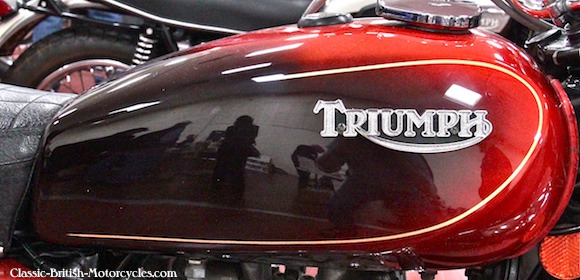
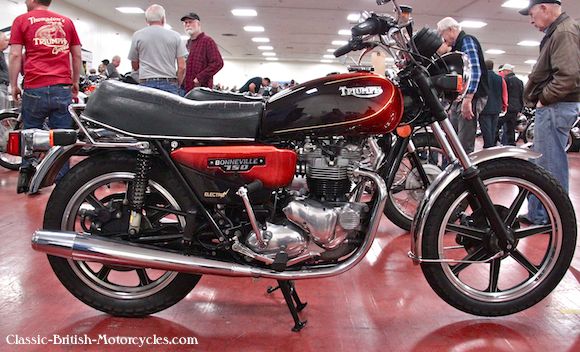
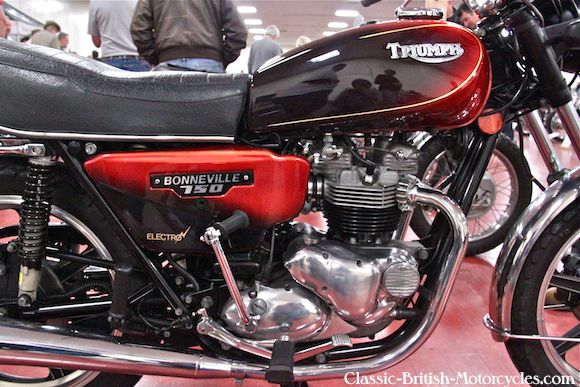
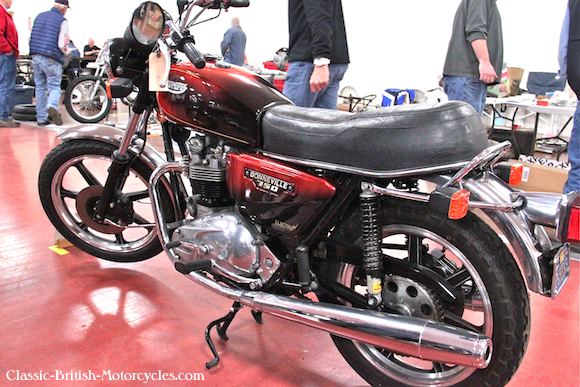
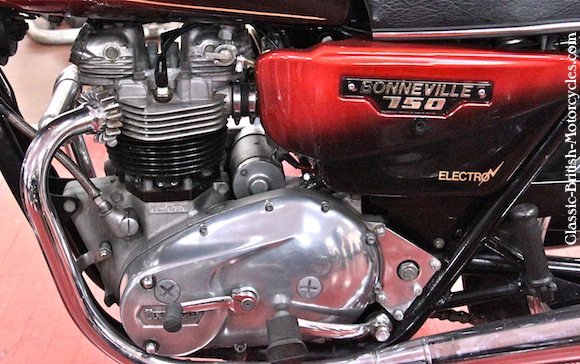
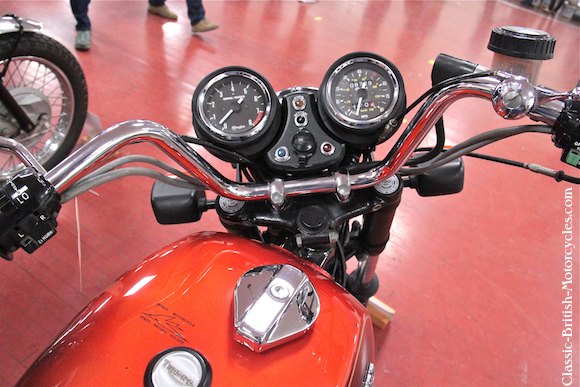
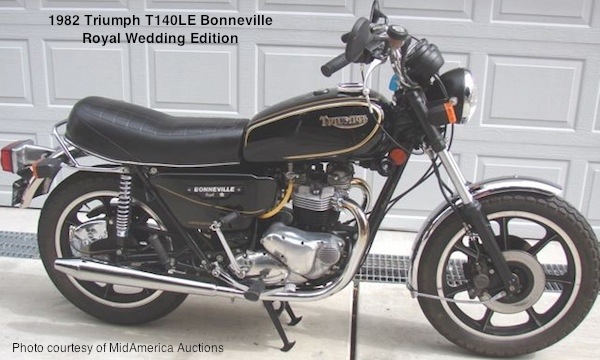
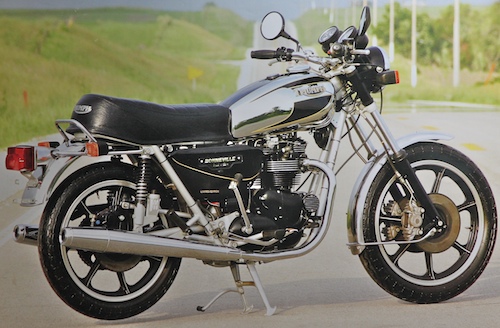
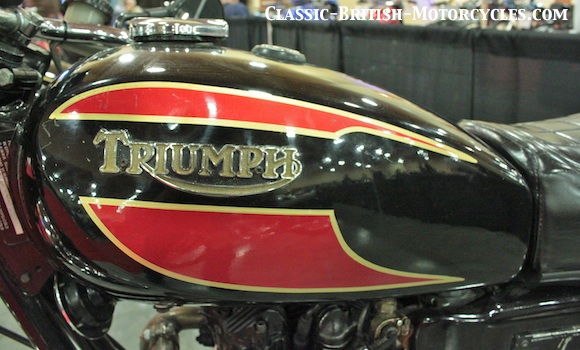
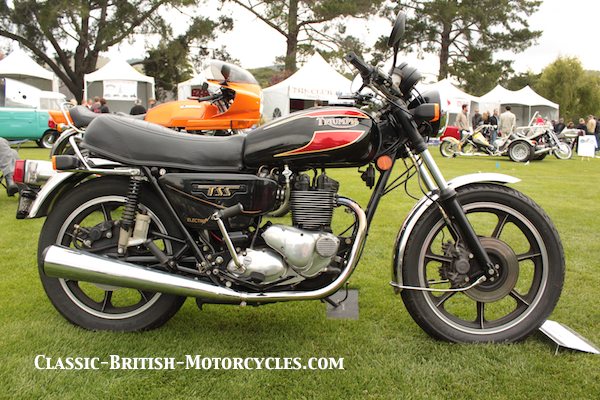
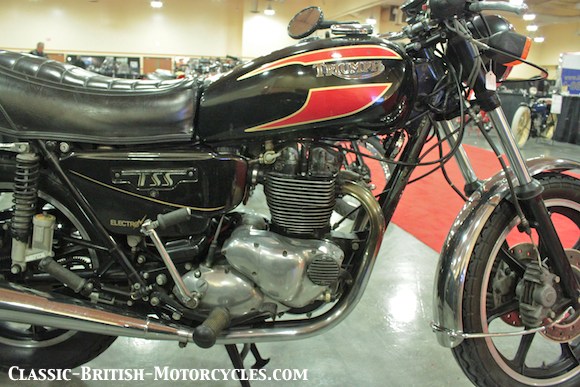
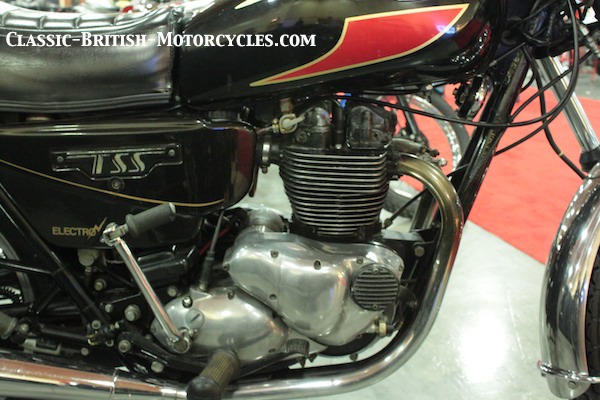
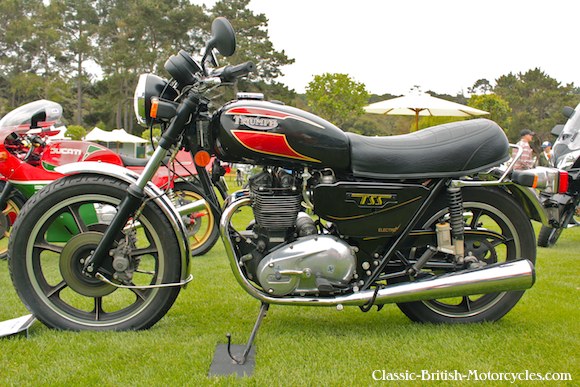
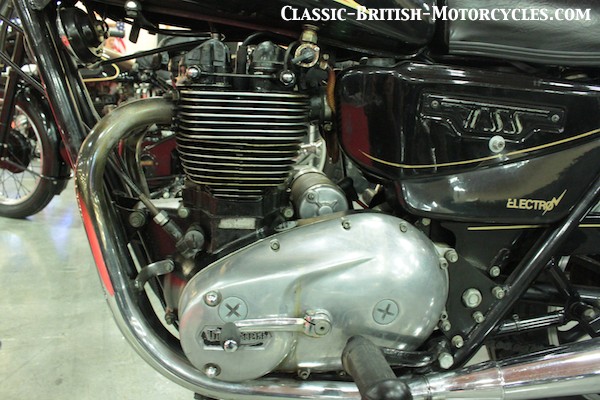
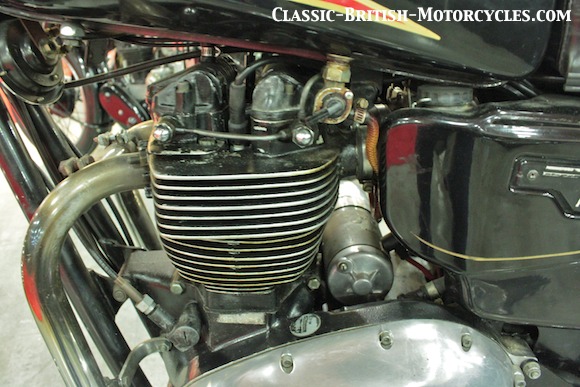
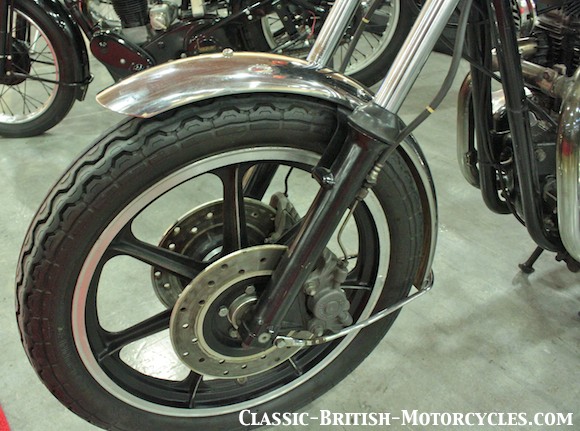
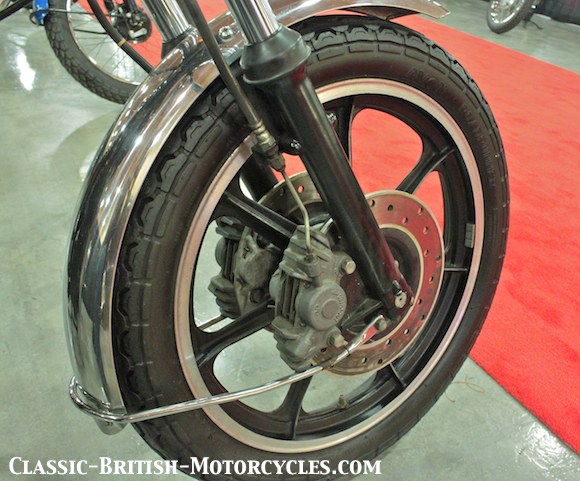
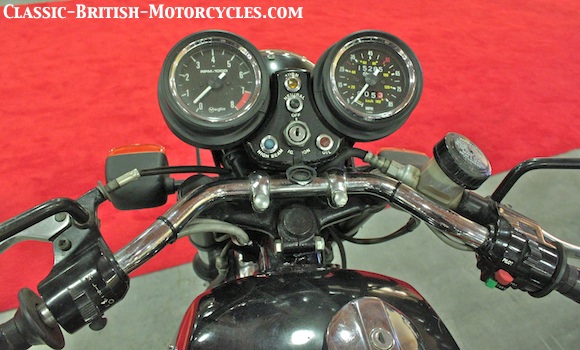
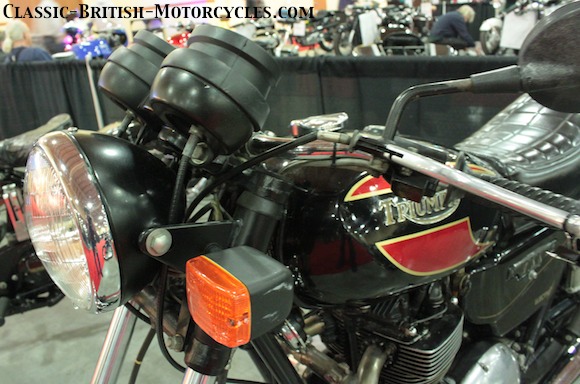

No Comment